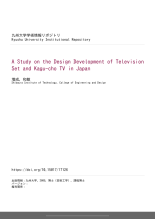1 0 0 0 OA P1-12-4 子宮頸部上皮内腫瘍におけるフェノール療法の有効性とその予後因子の分析(Group 12 CIN・その他・診断・治療2,一般演題,公益社団法人日本産科婦人科学会第66回学術講演会)
- 著者
- 前濱,俊之
- 出版者
- 日本産科婦人科学会
- 雑誌
- 日本産科婦人科學會雜誌
- 巻号頁・発行日
- vol.66, no.2, 2014-02-01
1 0 0 0 OA 本人訴訟と法律扶助 : ~Turner v. Rogers 事件の波紋
- 著者
- 山城 崇夫
- 雑誌
- 白鴎大学法科大学院紀要 = Hakuoh law review (ISSN:18824277)
- 巻号頁・発行日
- no.10, pp.33-54, 2017-03
- 著者
- 日本大学国文学会 編
- 出版者
- 日本大学国文学会
- 巻号頁・発行日
- vol.71, 1988-06
1 0 0 0 OA 真理の探究 : ルネサンス期の科学の進歩
- 著者
- 澤井 繁男
- 出版者
- 関西大学
- 雑誌
- 關西大學文學論集 (ISSN:04214706)
- 巻号頁・発行日
- vol.57, no.1, pp.A27-A52, 2007-07
1 0 0 0 IR 日本におけるテレビ受像機のデザイン変遷と家具調テレビの成立に関する研究
This paper summarizes the transition of TV design in Japan and the development of Kagu-cho style TV. When Japan imported the technology for TV from Western countries, they also imported designs. The consolet type with 4 detachable rounded legs, developed in the Western countries, became mainstream in Japan in the late 1950s. The Japanese console type in the 1960s had also 4 rounded legs but its design was not yet unique to Japan. In this period, the replacement demand constituted a large share of the demand for monochrome TV sets. Then, Kagu-cho TV was developed as a trigger for purchase. Behind the development of Kagu-cho TV in the mid-1960s was the modern Danish design. It was clear that Japanese Kagu-cho TV was not a follower of the American design considering the process of its birth. In newspaper ads at the time, the word “Kagu-cho” had been used before “Saga” was launched, and various manufacturers commercialized designs which expressed “Kagu-cho” style. The word “Kagu-cho” in the ads was one of the factors that created “Kagu-cho” design. At first, “Kagu-cho” didn’t necessarily mean Japanese style but later, “Saga”, whose name and design was Japanese style, was introduced with a big advertising campaign. The campaign created an image of Japanese style for Kagu-cho TV and made “Saga” its representative. The features of “Saga” were a projecting top board, speaker grille, the legs harmonized with the body and natural wooden texture. For the “Saga” series, various designs that differentiated from the 1st generation design were introduced. The design of “Saga” was influenced by “Asuka”. The reason why “Asuka” has an image of Japanese style is because the advertising campaign created an image in association with “Azekura-zukuri”, Japanese traditional structure. Considering the creation process of Kagu-cho TV in relation to design application, Sanyo Electric first applied patents for the design features that characterize “Saga”. Sanyo launched “Nihon”, a Kagu-cho style TV. This meant that behind the birth of Kagu-cho TV was the design trend at that period. To summarize, even though a design is created by an individual designer, the era and society is apparent in the background. Regarding TV sets, only the designs that were suitable for Japanese lifestyle survived among those brought in from the Western countries. Then Japanese manufacturers came to take into account design for product development and gradually Japanese unique design became more important. As a result, Kagu-cho TV emerged.
1 0 0 0 OA ワイン酵母による尿素およびアンモニアの利用と関与する発酵条件
- 著者
- 篠原 隆 柳田 藤寿
- 出版者
- 公益財団法人 日本醸造協会
- 雑誌
- 日本醸造協会誌 (ISSN:09147314)
- 巻号頁・発行日
- vol.94, no.7, pp.593-603, 1999-07-15 (Released:2011-09-20)
- 参考文献数
- 23
1.ワイン酵母 (S.cerevisiae) 48菌株の尿素およびアンモニアの利用性について, ブドウ果汁および窒素源添加ブドウ果汁を用いたアルコール発酵試験により検討した。供試酵母株の尿素およびアンモニアの消費量は, 初発濃度の40%から98%の範囲であった。供試菌株を尿素消費量に基づいて4グループに分けたところ, 多くの菌株が尿素高利用性 (消費量: 9.1~12.9mg/l) であり, 尿素低利用性 (消費量: 5.3~9.0mg/2) は少数であった。窒素源添加は一部の供試菌株の尿素消費を低下させた。アンモニアはいずれの供試菌株でも高利用性 (消費最: 16.1~19.6mg/l) であった。2.発酵における高温条件 (25, 30℃) は, 供試菌株の尿素消費を促進する傾向であり, 嫌気的条件は尿素消費を低下させる傾向であった。アンモニア消費は, これらの発酵条件下で良好であった。3.窒素源 (カザミノ酸, リン酸二アンモニウム, レアルギニン, 尿素) の添加による影響を, 発酵90日まで試験した。供試3株がリン酸ニアンモニウム, L-アルギニンおよび尿素の添加に影響された。とくに尿素低利用性の1株 (RIFY1062) は, 発酵中に尿素およびアンモニア濃度を増加させた。しかし, 他の供試2株においては, 窒素源添加の影響がみられなかった。4.甲州およびマスカット・ベリーAブドウを用いた小規模試験醸造において, 発酵もろみ中の尿素およびアンモニアは速やかに消費されて, 発酵以後も低レベルで推移した。本試験結果より, ワイン酵母による尿素利用性が明確となり, 尿素濃度を低レベル (5mg/l以下) とするための発酵条件が提示された。終わりに, 本研究にご協力下さいました成田真由美さん, 藤原真志さんに感謝いたします。
1 0 0 0 青春群像さようなら六本松 : 一九二一福高-九大二〇〇九
- 著者
- 九州大学さようなら六本松誌編集委員会編
- 出版者
- 花書院
- 巻号頁・発行日
- 2009
1 0 0 0 OA <研究ノート>中世菅浦における村落領域構成 : 景観復元を通して
- 著者
- 太田 浩司
- 出版者
- 史学研究会 (京都大学文学部内)
- 雑誌
- 史林 (ISSN:03869369)
- 巻号頁・発行日
- vol.70, no.4, pp.620-655, 1987-07-01
個人情報保護のため削除部分あり
1 0 0 0 OA 供御人と惣 : 近江菅浦の歴史
- 著者
- 赤松 俊秀
- 出版者
- 京都大學文學部
- 雑誌
- 京都大學文學部研究紀要 (ISSN:04529774)
- 巻号頁・発行日
- vol.4, pp.397-449, 1956-11-20
この論文は国立情報学研究所の学術雑誌公開支援事業により電子化されました。
1 0 0 0 OA 万葉集伝本の研究
- 著者
- 田中 大士 タナカ ヒロシ Hiroshi TANAKA
- 出版者
- 総合研究大学院大学
- 巻号頁・発行日
- 2015-03-24
- 著者
- 吉留 公太 ヨシトメ コウタ
- 出版者
- 神奈川大学経営学部
- 雑誌
- 神奈川大学国際経営論集 = Kanagawa University international management review (ISSN:09157611)
- 巻号頁・発行日
- no.54, pp.19-47, 2017-10
研究論文
1 0 0 0 OA 書評「ゲームデザイナーの仕事」
- 著者
- 井上 明人
- 出版者
- 日本デジタルゲーム学会
- 雑誌
- デジタルゲーム学研究 (ISSN:18820913)
- 巻号頁・発行日
- vol.2, no.1, pp.170-171, 2008 (Released:2021-07-01)
1 0 0 0 OA 「音程」理解のための一考察 : 歌唱教材の演奏につなげる為に
- 著者
- 志澤 彰
- 出版者
- 国士舘大学初等教育学会
- 雑誌
- 初等教育論集 = SHOTO KYOIKU RONSHU = THE JAPANESE JOURNAL OF PRIMARY EDUCATION (ISSN:13462555)
- 巻号頁・発行日
- vol.17, pp.70-79, 2016-03-01
1 0 0 0 OA 「学問の自由」,「大学の自治」と大学内部の法関係 (1)
- 著者
- 片山 等
- 出版者
- 國士舘大學比較法制研究所
- 雑誌
- 比較法制研究 (ISSN:03858030)
- 巻号頁・発行日
- vol.27, 2004
1 0 0 0 複雑系・進化動学理論の社会・経済への応用
西垣と佐竹は、日本の景気循環がカオス理論により説明できるかどうかを実証的に検証するため、日本のGDPデータを用い低次元の決定論的な周期を検出するための「残差診断法」を適用し分析をおこなった。この成果は、2007年8月の国際会議(10^<th> International Conference of the Society of Global Business and Economic Development)において報告する予定である。さらに、設備投資、株価、株価収益率などの複雑な循環的振動を示す時系列データを用いて、複雑性の実証分析を進めた。これらの成果は、順次論文として取りまとめ、今後、学会・国際会議等で報告する予定である。寺田、西垣、伊藤は、複素ロジスティック方程式の経済学への応用に関する成果("An application of complex logistic equation to economics")を再検討したうえで、第63回日本経済政策学会、および、第11回差分方程式とその応用国際会議(11^<th> International Conference on Difference Equations and Applications)において報告した。さらに、複素ロジスティック方程式の一層の応用研究として、粗鋼などの鉱工業生産データ、金融・実物資産などの資産ストックデータ、工業製品普及率などのデータを解析し、シミュレーション研究を進めた。寺田は、ケインジアン動学を線型ではなく非線形動学として分析するために、(1)リエナール微分方程式、(2)ファン・デル・ポール微分方程式の数学的特性の研究に特化した。この成果は、今後、学術雑誌に発表するとともに国際会議(10^<th> International Conference of the Society of Global Business and Economic Development)において報告する予定である。伊藤は、B.Scardua教授との共同研究で、CP(n)上の線型双曲線ベクトル場の幾何学的特徴づけをした。また、フランスの数学研究所CIRMで開催された国際会議「Dynamical Integrability」(2006年11月27-12月1日)で研究報告をした。
1 0 0 0 OA 結婚市場における過大評価または過小評価の厚生分析
- 著者
- 丸山 亜希子
1 0 0 0 OA ワインのメトキシピラジン化合物
- 著者
- 橋爪 克己
- 出版者
- 公益財団法人 日本醸造協会
- 雑誌
- 日本醸造協会誌 (ISSN:09147314)
- 巻号頁・発行日
- vol.94, no.12, pp.966-973, 1999-12-15 (Released:2011-09-20)
- 参考文献数
- 30
ワインでは, ブドウの品種, 生産地域や気象条件さらには収穫時期などが重要視されている。メトキシピラジン化合物は, これまでカベルネ・ソービニヨン種の特徴的な香り成分と報告されているが, 検出及び定量が困難な化合物であった。本稿では, ブドウ及びワインにおけるメトキシピラジン化合物の挙動について解脱していただきたい。今後, 日本におけるブドウの栽培, さらにはワイン醸造への進展が期待される。



